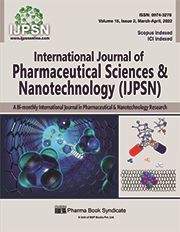Preparation and Evaluation of Nail Lacquer containing Luliconazole as Ungual Drug Delivery System
DOI:
https://doi.org/10.37285/ijpsn.2022.15.3.4Abstract
Background: The primary goal of developing the antifungal nail lacquer is to determine its suitability for delivering medicine to the desired location. Because the area between the nail and the skin is commonly impacted, topical treatment is difficult to reach. Statistical techniques were used in this study to understand the source of variables.
Methods: Nail lacquer formulations were prepared using luliconazole using a simple mixing method. The drug's permeability was made better by using the permeation enhancers in different amounts.
Results: The drug-excipient study revealed no physical or chemical interaction, while the standard calibration curve showed that the drug follows Beers-Lamberts' law with a coefficient value of 0.984. The medicated nail lacquer was evaluated for various parameters such as non-volatile content, which was in the range of 37.020.72-43.050.57%, drying time was found to be in the range of 42-97 seconds, water resistance was found to be 0.10-0.24gm, the drug content in the prepared nail paint was found to be in the range of 94.331.52-98.33.51%, and the drug release study revealed the drug release in the range of 0.70.1-51.580.28%, which shows satisfactory results. The antifungal study revealed a zone of inhibition for the prepared nail paint of 47 mm, which was the highest among all the formulations and also the highest among the studies conducted with pure drug and control formulation. The stability study revealed that the optimised formulation, i.e., F2, was stable during the time span of the study, and hence it was concluded that the prepared formulation was stable.
Conclusion: From the results above, it can be concluded that nail lacquer containing luliconazole could be a promising drug delivery system for treating fungal nail infections.
Downloads
Metrics
Keywords:
Nail Lacquer, Antifungal, Luliconazole, Permeation Enhancer, OnychomycosisDownloads
Published
How to Cite
Issue
Section
References
Al-Galibi, H. H., & Imran, Z. K. (2014). Evaluated Onchomycosis Distribution Incidance With Age And Gender. International Journal of Innovation and Applied Studies, 9(2), 672.
Blaschke-Hellmessen, R., & Seebacher, C. (1972). Statistical report on mycological studies in onchomycosis and tinea pedis in the GDR.(1967-1969). Dermatologische Monatschrift, 158(4), 310-323.
Bohn, M., & Kraemer, K. T. (2000). Dermatopharmacology of ciclopirox nail lacquer topical solution 8% in the treatment of onychomycosis. Journal of the American Academy of Dermatology, 43(4), S57-S69.
Elewski, B. E., Rich, P., Tosti, A., Pariser, D. M., Scher, R., Daniel, R. C., & Gupta, A. K. (2013). Onchomycosis: an overview. J Drugs Dermatol, 12(7), s96-s103.
Gupta, A. K., Fleckman, P., & Baran, R. (2000). Ciclopirox nail lacquer topical solution 8% in the treatment of toenail onychomycosis. Journal of the American Academy of Dermatology, 43(4), S70-S80.
Guideline, I. H. T. (2003). Stability testing of new drug substances and products. Q1A (R2), current step, 4, 1-24.
Lin, T. Y. D., & Chen, C. W. (2003). Overview of stability study designs. Journal of biopharmaceutical statistics, 13(3), 337-354.
Malviya VR, Pande SD, Bobade NN. Preparation and Evaluation of Sustained Release Beads of Zolmitriptan Hydrochloride. Research Journal of Pharmacy and Technology. 2019;12(12):5972-6.
Malviya, V., & Manekar, S. (2021). Design, Development and Evaluation of Aceclofenac and Curcumin Agglomerates by Crystallo Co-Agglomeration Technique. Research Journal of Pharmacy and Technology, 14(3), 1535-1541.
Malviya, V. R., & Pande, S. D. (2019). Road CKN. Preparation ad Evaluation of Zolmitriptan Hydrochloride Lozenge. J Pharma Res, 8(8), 624-629.
Malviya, V., Thakur, Y., Gudadhe, S. S., & Tawar, M. (2020). Formulation and evaluation of natural gum based fast dissolving tablet of Meclizine hydrochloride by using 3 factorial design 2. Asian Journal of Pharmacy and Pharmacology, 6(2), 94-100.
Malviya, V., Ladhake, V., Gajbiye, K., Satao, J., & Tawar, M. (2020). Design and Characterization of Phase Transition System of Zolmitriptan Hydrochloride for Nasal Drug Delivery System. International Journal of Pharmaceutical Sciences and Nanotechnology, 13(3), 4942-4951.
Mazzo, D. J. (2020). The ICH stability guideline. In International Stability Testing (pp. 1-13). CRC Press.
Malviya, V. (2021). Preparation and Evaluation of Emulsomes as a Drug Delivery System for Bifonazole. Indian Journal of Pharmaceutical Education And Research, 55(1), 86-94.
Marty, J. P. L. (1995). Amorolfine nail lacquer: a novel formulation. Journal of the European Academy of Dermatology and Venereology, 4, S17-S21.
Patel, R. P., Naik, S. A., Patel, N. A., & Suthar, A. M. (2009). Drug delivery across human nail. Int J Curr Pharm Res, 1(1).
Scher, R. K., Nakamura, N., & Tavakkol, A. (2014). Luliconazole: a review of a new antifungal agent for the topical treatment of onychomycosis. Mycoses, 57(7), 389-393.
Uchida, K., Nishiyama, Y., & Yamaguchi, H. (2004). In vitro antifungal activity of luliconazole (NND-502), a novel imidazole antifungal agent. Journal of infection and chemotherapy, 10(4), 216-219.
Yoshida, S., Kasuga, S., Hayashi, N. O. R. I. H. I. R. O., Ushiroguchi, T., Matsuura, H., & Nakagawa, S. (1987). Antifungal activity of ajoene derived from garlic. Applied and Environmental Microbiology, 53(3), 615-617.






